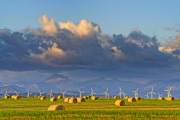It’s dusk on the outskirts of a typical small town. You’re out for a brisk winter’s walk but want to get back home before it gets dark. That’s when you notice something that’s not so strange these days. All the lights in the town are out. For the average home, electricity is unavailable 20 per cent of the time. The electricity company announces outages of a month or more at a time. That’s on top of the unplanned breakdowns like this one, where power goes out without even a moment’s notice.
Is this a description of a future in Alberta with renewables? Hardly — this is a description of what our electricity system would be like without a diverse grid network. If we relied only on individual large-scale generators, like coal plants, to supply our energy, we could be facing the future described above. For example, coal plants in Alberta are designed to run about 80 per cent of the time. They can’t just be turned on and off as demand changes— after being shut down they require as long as 14 hours before they are up and running again. And we haven’t even mentioned the times they were turned off on purpose to manipulate prices.
A sophisticated network
Luckily for all of us, our electricity system is a sophisticated grid network where all types of power generation work together to cover planned and unplanned outages, along with unpredictable fluctuating demand, ensuring near-constant electricity availability. Concerns about the ability of renewables to provide reliable power, or belief that renewables need some sort of special backup on the grid, come from a complete misunderstanding of our electricity system and the power of the network.
This is why a recent comment made by Robin Campbell, president of the Coal Association of Canada, must be refuted. While conducting coal information meetings across Alberta, Campbell said, “There's no reliability in solar or wind power. [In Alberta] we have five or six hours a day of sunlight in winter. And the wind doesn't always blow.”
 The wind doesn’t always blow, just like a coal plant — or any machine — doesn’t always operate. In fact, the changes in wind or solar energy can be easier for grid operators to manage as they can be predicted in advance quite accurately through weather forecasting. Wind turbines are relatively simple machines and a wind facility continues to generate power even when a few turbines are offline for repairs, whereas fossil-fueled power plant outages happen without warning and typically involve fast, large reductions in power as a whole unit goes offline at once.
The wind doesn’t always blow, just like a coal plant — or any machine — doesn’t always operate. In fact, the changes in wind or solar energy can be easier for grid operators to manage as they can be predicted in advance quite accurately through weather forecasting. Wind turbines are relatively simple machines and a wind facility continues to generate power even when a few turbines are offline for repairs, whereas fossil-fueled power plant outages happen without warning and typically involve fast, large reductions in power as a whole unit goes offline at once.
Renewables also offer other advantages to the grid and consumers that coal doesn’t. For some sources, individual generators are smaller and more geographically diverse, naturally providing a distributed network that is more robust against breakdowns. This also compensates for variability as weather varies across the grid. Not to mention the types of renewables that can be turned on, on command. The scalable nature of renewables fosters more diverse ownership, reducing the opportunities for market manipulation.
Reliable power can include renewables
 This isn’t a theory — it’s being proven worldwide. Grid operators are a highly capable bunch and conservative by nature to ensure they deliver on their mandate of providing reliable power. As renewable penetration has increased in grids across the world, grid operators have shown their ability to manage during even the most extreme events such as a solar eclipse or wildly varying wind speeds.
This isn’t a theory — it’s being proven worldwide. Grid operators are a highly capable bunch and conservative by nature to ensure they deliver on their mandate of providing reliable power. As renewable penetration has increased in grids across the world, grid operators have shown their ability to manage during even the most extreme events such as a solar eclipse or wildly varying wind speeds.
And this is why investment in renewable energy continues to grow globally, in the face of massive cuts in other energy commodities, with US$329 billion invested in renewable energy in 2015, up four per cent from the 2014 investment. Renewables were the biggest source of new power added to the grid in the U.S. in 2015 at 68 per cent of new capacity.
It's time for Alberta to catch up to what is already being embraced worldwide: renewables work, and they’re the way of the future.









